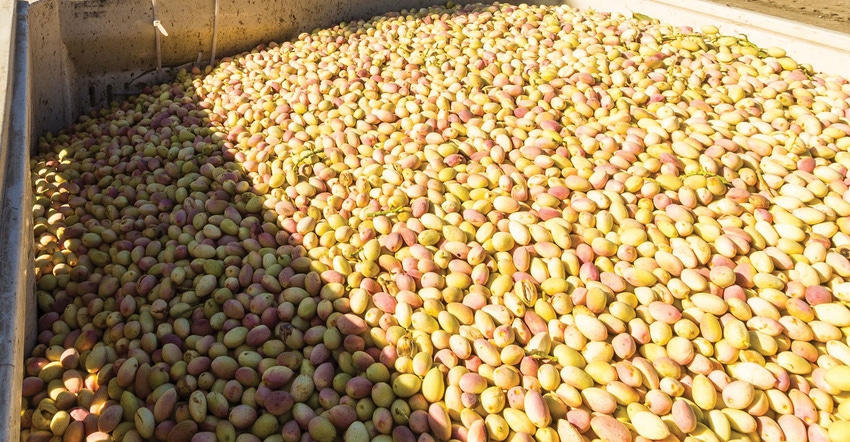
The jury is still debating exactly what kind of harvest was produced in 2020, which was supposed to be an on-year for pistachios. Rabobank headlines still insist “On Year for US Pistachios Still On” and that production will most likely exceed the billion-pound milestone to set a new record.
"However," the Rabobank Market Outlook reports, "the crop may not be as large as many previously expected as some issues during bloom impacted yield prospects. Chill hours were fair, but growers reported issues during pollination in some growing regions of California which may be reflected in lower-than-expected yields this year." Hence, a crop in excess of 1.1 billion pounds is now less likely, but still a possibility.
When it comes to pistachios, Bob Klein, manager of the California Pistachio Research Board, has some numbers of his own for both 2020 harvest and a projected 2021 yield.
“2020 was a record crop and the 2021 crop will be a function of that record,” he told a Zoom audience at the recent Statewide Pistachio Day. “The U.S. crop came back from an off-year at 1.05 billion pounds. In California, there were 371,000 bearing acres with an average yield of 2,806 pounds per acre.”
With 114,000 acres still classified as non-bearing, there are 485,000 total acres in the ground in California, he noted.
But where pistachios used to be a well-accepted on-then-off-year crop, that distinction has narrowed and is now a bit more nebulous. “We used to be able to predict next year’s crop as a function of the crop we had the previous year as pistachios are known as alternate-bearing,” he said. “But recently that hasn’t turned out to be much of a rule.
“That history and a second factor of how much of a chill we have had should be the two primary drivers of what we can expect for the coming yield, but my question is — was 2020 really on on-year crop?” he said. “There are many years since the early 1990s where we have had exceptions with back-to-back on years. In the last 15 years, even counting drought years, we’ve had six years where things didn’t follow that alternate-bearing plan in the way of poundage and quality.
“In 2020, open in-shell constituted 83% of harvest which is really on the high side. Normally in an on year, we see about 75% open in-shell. And usually in an off year, nut size is smaller, but this year (2020) average nut size was quite large.”
What’s ahead in 2021?
So what to these changes portend for the 2021 crop? “This year fog has been far more extensive than normal with above-normal high temperatures and we really don’t know what the plants are doing with that,” he said.
With so many inconsistencies, Klein questions whether 2020 should be categorized as an on or an off year. “Going into 2021, we have about 409,000 bearing acres,” he said. “If 2020 was an on year and 2021 should be an off year, we normally would expect about 2,300 pounds per acre and we could be looking at close to 1.4 billion pounds. But if we look at previous unanticipated back-to-back totals and the same holds true for 2021, we could come in with another record crop in the neighborhood of 1.5 to 1.6 billion pounds next year.”
Insect damage, for the third year in a row, was low. “We’ve never even seen two years in a row, so having three years is unprecedented,” he said. “Growers have been increasing their efforts at controlling navel orange worm activities following the damaging 2017 crop and as long as the hulls stay intact, the nut inside is largely protected. Early splits the past three years have been low and hull integrity has been good throughout harvest.
“Growers are also doing a better job with their fertilization and irrigation programs and the plants may be responding. It’s important for individual growers to look at whatever they can do to maintain their margins.”
For more news on tree nuts as reported by growers and farm advisors, subscribe to the Tree Nut Farm Press e-newsletter.
Read more about:
PistachiosAbout the Author(s)
You May Also Like




